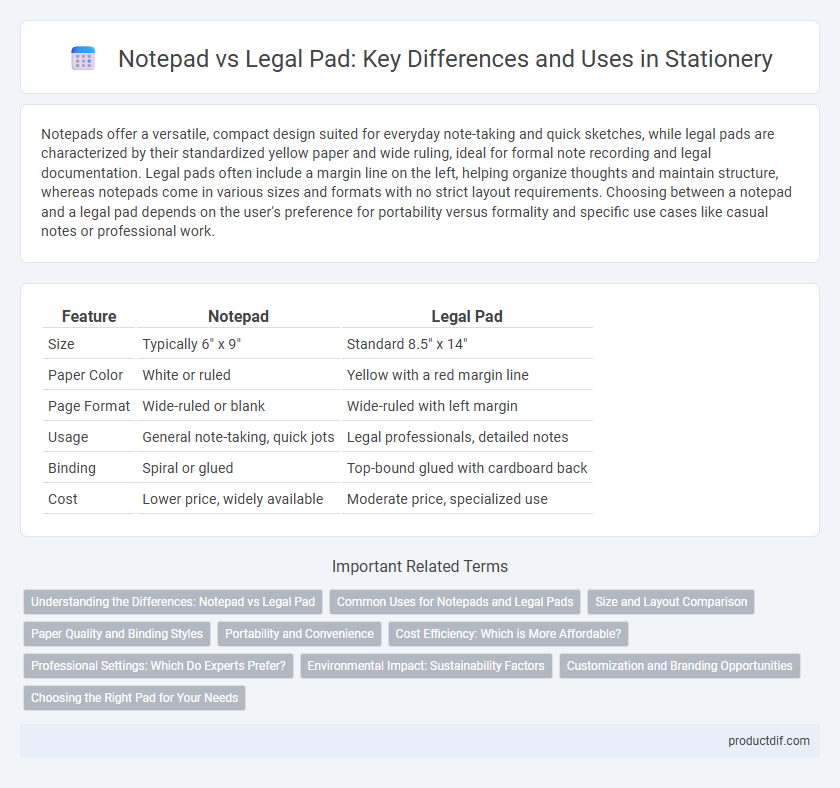Notepads offer a versatile, compact design suited for everyday note-taking and quick sketches, while legal pads are characterized by their standardized yellow paper and wide ruling, ideal for formal note recording and legal documentation. Legal pads often include a margin line on the left, helping organize thoughts and maintain structure, whereas notepads come in various sizes and formats with no strict layout requirements. Choosing between a notepad and a legal pad depends on the user's preference for portability versus formality and specific use cases like casual notes or professional work.
Table of Comparison
| Feature | Notepad | Legal Pad |
|---|---|---|
| Size | Typically 6" x 9" | Standard 8.5" x 14" |
| Paper Color | White or ruled | Yellow with a red margin line |
| Page Format | Wide-ruled or blank | Wide-ruled with left margin |
| Usage | General note-taking, quick jots | Legal professionals, detailed notes |
| Binding | Spiral or glued | Top-bound glued with cardboard back |
| Cost | Lower price, widely available | Moderate price, specialized use |
Understanding the Differences: Notepad vs Legal Pad
Notepads typically feature plain or ruled pages in various sizes, designed for general note-taking and casual use, while legal pads are characterized by their standard 8.5 x 14-inch dimensions and a distinctive yellow color with a red margin line on the left. Legal pads are optimized for legal professionals, providing ample space for extensive notes and organization, whereas notepads offer versatility for everyday tasks across diverse settings. Understanding these differences helps in selecting the appropriate writing tool based on purpose, size preference, and professional requirements.
Common Uses for Notepads and Legal Pads
Notepads are commonly used for quick notes, to-do lists, and casual writing due to their compact size and portability. Legal pads are favored in professional settings such as law offices and meetings for detailed note-taking, drafting documents, and organizing legal work with their standardized lined format and margin. Both serve distinct purposes, with notepads ideal for brief, informal notes and legal pads suited for structured, extensive writing tasks.
Size and Layout Comparison
Notepads typically come in various sizes such as 5x8 inches or A5, offering flexible layouts including blank, ruled, or grid pages, ideal for general note-taking and sketches. Legal pads are standardized at 8.5x14 inches with narrow-ruled lines and a distinctive left margin, designed specifically for legal documentation and detailed note organization. The larger size and uniform layout of legal pads provide more writing space and better alignment for formal notes compared to the diverse and compact forms of standard notepads.
Paper Quality and Binding Styles
Notepads typically feature smooth, high-quality paper with versatile binding options such as spiral or glue-bound edges, ensuring easy page removal and durability. Legal pads use yellow or white recycled paper with a slightly rougher texture, bound at the top edge with a glued strip that allows quick detachment. Both offer distinct paper weights and finishes, catering to different writing needs and preferences.
Portability and Convenience
Notepads are typically smaller and lighter, enhancing portability for quick notes on the go, while legal pads offer larger pages that can be cumbersome to carry but provide more writing space. The compact size of notepads fits easily into bags or pockets, making them ideal for frequent use and travel convenience. Legal pads, often used in professional settings, prioritize ample writing area over portability, which may limit their ease of handling outside the office.
Cost Efficiency: Which is More Affordable?
Notepads generally offer greater cost efficiency due to their smaller size and lower paper weight, making them more affordable for everyday note-taking. Legal pads, characterized by their larger dimensions and often higher-quality paper, tend to carry a higher price point but provide more writing space per sheet. Choosing between a notepad and a legal pad depends on balancing budget constraints against the need for extensive writing area.
Professional Settings: Which Do Experts Prefer?
Legal pads are favored in professional settings due to their standardized yellow paper and numbered lines, which enhance organization and readability during meetings or legal documentation. Notepads offer greater variety in size, color, and ruling, making them suitable for creative brainstorming and informal note-taking. Experts often select legal pads for formal tasks requiring structure, while notepads serve well for flexible, casual note capture.
Environmental Impact: Sustainability Factors
Notepads made from recycled paper significantly reduce deforestation and energy consumption compared to traditional legal pads, which often use virgin paper sourced from unsustainable forestry. Legal pads typically contain a synthetic binding or glue, limiting their recyclability, whereas many eco-friendly notepads utilize biodegradable materials and soy-based inks. Choosing notepads with certifications like FSC or those labeled chlorine-free ensures a lower carbon footprint and promotes responsible sourcing in stationery products.
Customization and Branding Opportunities
Notepads offer versatile customization options, including various sizes, paper types, and cover designs, making them ideal for personalized branding. Legal pads typically feature a standardized format with a yellow lined page and a margin, limiting customization but providing a distinctive professional appearance. Businesses seeking unique branding elements often prefer notepads for their flexibility in logo placement, color choices, and page layout adjustments.
Choosing the Right Pad for Your Needs
Notepads offer versatile usage with various sizes and plain or ruled pages, ideal for everyday note-taking and quick ideas. Legal pads feature a distinctive yellow color, a left margin line for structured writing, and typically include 50-100 sheets, making them perfect for legal professionals and organized note recording. Selecting the right pad depends on your specific needs, such as portability, page layout, and purpose-driven design to enhance productivity and ease of use.
Notepad vs Legal Pad Infographic

 productdif.com
productdif.com